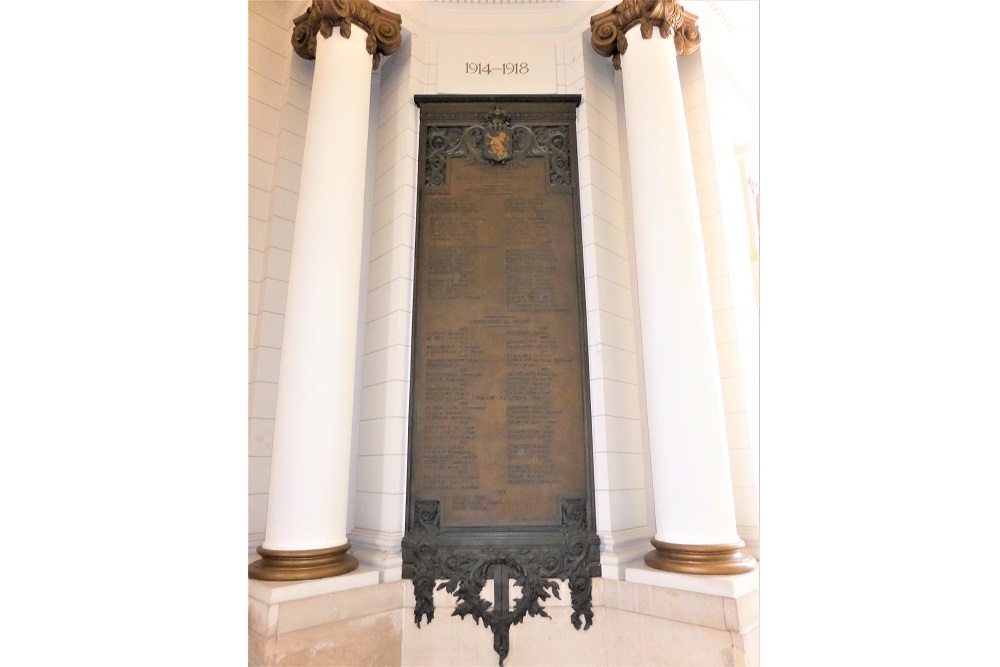Memorials Royal Military School
Shortly after the independence struggle in November 1830, Leopold I founded a Military School on February 7, 1834 to train the officers of the artillery and the engineers.
The officers of the other weapons only received practical training and came mainly from the non-commissioned officer corps.
In 1914 the studies of the student officers were interrupted and they left for the Camp of Beverlo to train in command. On July 30, 1914, these officer-apprentices were called up to arms. On August 1, 1914, General Eugène Cuvelier closed the Military School. The framework of the school was spread over the operational units.
When the Germans entered Brussels on 20 August 1914, they also occupied the buildings of the Military School. This occupation would continue until November 16, 1918. The German occupier had taken almost all collections, laboratory equipment and furniture.
About 300 former students of the Military School were killed in the First World War.
On November 22, 1922, four bronze memorial plaques in the entrance hall of the staff block in honor of these fallen "anciens" were inaugurated.
"Military School
To his dead fallen gloriously doden
for the fatherland"
While the number of students in the 1920s was often very low, especially in the Infantry-Cavalry division, the number of students rose again very quickly as World War II approached.
Until the mobilization of 1939, the entire Peacetime Staff of the Belgian army was in the staff block of the Military School. The Wartime Staff went to the fortress of Breendonk.
With the mobilization of 1939, the courses were suspended, as the officers and professors had to go to their units. However, the Staff decided to resume courses on September 14; for this, a small part of the cadre from the mobilized units was recalled. Thanks to an accelerated training, the students of the 96th Artillerie-Genie were able to finish their studies at the beginning of May 1940. They celebrated their farewell on the evening of 9 May 1940, the next day the Germans invaded Belgium early in the morning.
At the outbreak of hostilities, the KMS was again disbanded and the students went to the instruction centers for the various weapons. In the course of the war, pupils, members of the cadres and of the professorial corps ended up in the resistance, in England, in prison camps, in Congo, in the Middle East, etc ...
During the Second World War, 202 former students of the KMS were killed.
After the war, copper plaques were also unveiled for them.
" 1940 – 1945 - Spe occubuerunt invicta", including the names classified according to rank:
Academics - Infantry Cavalry - Artillery Engineers - Personnel
Source : Wikipedia
Do you have more information about this location? Inform us!
Source
- Text: Marie-Christine Vinck
- Photos: Marie-Christine Vinck
Nearby
Museum
Point of interest
- Royal Museums of Fine Arts of Belgium - Brussels
- Watch Building Bloc Dubreucq - Brussel
- Law Courts of Brussels - Brussel
Monument
- Memorial Belgian Military Air Force - Brussel
- Memorial Ardennes Hunters Schaarbeek - Schaarbeek (Brussel)
- Monument Yser Metro Station - Etterbeek (Brussel)
Cemetery
- Park of Honour of Those Who Were Shot - Brussel
- Congress Column - Tomb of the Unknown Soldier - Brussel
- Belgian Graves Veterans Sint-Lambrechts-Woluwe - Sint-Lambrechts-Woluwe (Brussel)
Remembrance Stone
- Stumbling Stone Notelaarstraat 328 - Schaarbeek (Brussel)
- Stumbling Stones Rue Belliard 135 - Brussel
- Stumbling Stones Rue Archimède 22 - Brussel





